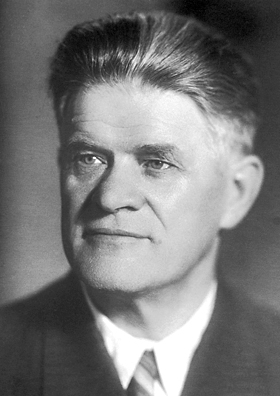Pavel Cherenkov (nonfiction): Difference between revisions
No edit summary |
No edit summary |
||
| Line 15: | Line 15: | ||
In 1934, while working under S. I. Vavilov, Cherenkov observed the emission of blue light from a bottle of water subjected to radioactive bombardment. This phenomenon, associated with charged atomic particles moving at velocities greater than the phase velocity of light, proved to be of great importance in subsequent experimental work in nuclear physics, and for the study of cosmic rays. Eponymously, it was dubbed the Cherenkov effect, as was the Cherenkov detector, which has become a standard piece of equipment in atomic research for observing the existence and velocity of high-speed particles. The device was installed in Sputnik 3. | In 1934, while working under S. I. Vavilov, Cherenkov observed the emission of blue light from a bottle of water subjected to radioactive bombardment. This phenomenon, associated with charged atomic particles moving at velocities greater than the phase velocity of light, proved to be of great importance in subsequent experimental work in nuclear physics, and for the study of cosmic rays. Eponymously, it was dubbed the Cherenkov effect, as was the Cherenkov detector, which has become a standard piece of equipment in atomic research for observing the existence and velocity of high-speed particles. The device was installed in Sputnik 3. | ||
Cherenkov also shared in the development and construction of electron accelerators and in the investigation of photo-nuclear and photo-meson reactions. | |||
== In the News == | |||
<gallery> | |||
</gallery> | |||
== Fiction cross-reference == | |||
* [[Crimes against physical constants]] | |||
* [[Gnomon algorithm]] | |||
* [[Gnomon Chronicles]] | |||
== Nonfiction cross-reference == | |||
* [[Cherenkov radiation (nonfiction)]] | * [[Cherenkov radiation (nonfiction)]] | ||
* [[Ilya Frank (nonfiction)]] | * [[Ilya Frank (nonfiction)]] | ||
* [[Physics (nonfiction)]] | |||
* [[Igor Tamm (nonfiction)]] | * [[Igor Tamm (nonfiction)]] | ||
External links: | |||
* [https://en.wikipedia.org/wiki/Pavel_Cherenkov Pavel Cherenkov] @ Wikipedia | |||
Attribution: | |||
[[Category:Nonfiction (nonfiction)]] | |||
[[Category:People (nonfiction)]] | |||
[[Category:Photographs (nonfiction)]] | |||
[[Category:Physicists (nonfiction)]] | |||
[[Category:Portraits (nonfiction)]] | |||
[[Category:Scientists (nonfiction)]] | |||
Revision as of 18:03, 6 January 2020
Pavel Alekseyevich Cherenkov (Russian: Па́вел Алексе́евич Черенко́в [ˈpavʲɪɫ ɐlʲɪˈksʲeɪvʲɪtɕ tɕɪrʲɪnˈkof], July 28, 1904 – January 6, 1990) was a Soviet physicist who shared the Nobel Prize in physics in 1958 with Ilya Frank and Igor Tamm for the discovery of Cherenkov radiation, made in 1934.
Biography
Cherenkov was born in 1904 to Alexey Cherenkov and Mariya Cherenkova in the small village of Novaya Chigla. This town is in present-day Voronezh Oblast, Russia.
In 1928, he graduated from the Department of Physics and Mathematics of Voronezh State University. In 1930, he took a post as a senior researcher in the Lebedev Physical Institute. That same year he married Maria Putintseva, daughter of A.M. Putintsev, a Professor of Russian Literature. They had a son, Alexey, and a daughter, Yelena.
Cherenkov was promoted to section leader, and in 1940 was awarded the degree of Doctor of Physico-Mathematical Sciences. In 1953, he was confirmed as Professor of Experimental Physics. Starting in 1959, he headed the institute's photo-meson processes laboratory. He remained a professor for fourteen years. In 1970, he became an Academician of the USSR Academy of Sciences.
Cherenkov died in Moscow on January 6, 1990, and was buried in Novodevichy Cemetery.
Discoveries in physics
In 1934, while working under S. I. Vavilov, Cherenkov observed the emission of blue light from a bottle of water subjected to radioactive bombardment. This phenomenon, associated with charged atomic particles moving at velocities greater than the phase velocity of light, proved to be of great importance in subsequent experimental work in nuclear physics, and for the study of cosmic rays. Eponymously, it was dubbed the Cherenkov effect, as was the Cherenkov detector, which has become a standard piece of equipment in atomic research for observing the existence and velocity of high-speed particles. The device was installed in Sputnik 3.
Cherenkov also shared in the development and construction of electron accelerators and in the investigation of photo-nuclear and photo-meson reactions.
In the News
Fiction cross-reference
Nonfiction cross-reference
- Cherenkov radiation (nonfiction)
- Ilya Frank (nonfiction)
- Physics (nonfiction)
- Igor Tamm (nonfiction)
External links:
- Pavel Cherenkov @ Wikipedia
Attribution:
